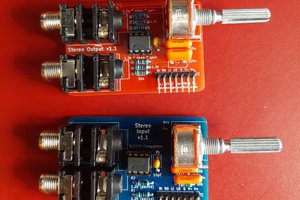BOM available at https://wtfamps.files.wordpress.com/2016/05/muchedumbre-bom.pdf
Notes on specific partsCAPSThe input coupling capacitor (.33uF) can be much smaller without sacrificing bass. The input impedance will be approximately the grid leak resistor (1M) divided by one minus the gain of the stage. The gain of the stage is almost one so the input impedance is yo-mama-huge. You could use a coupling cap a hundred times smaller (.0033uF) and not notice any roll off of the bass. The bass will have a -3db point at frequency (f) according to the following:
f = 1 / (2 * pi * C * a bigass number)
I spec’d .33uF here because I like the Cornell Dubilier 940C series of caps and this was the cheapest in that series. That’s all. Feel free to experiment.
The output capacitor should stay around 1uF or higher. With a hypothetical 25,000 ohm input impedance on your amplifier, this cap will create a -3db point around 5hz. With a 10,000 ohm input impedance, it will be around 15hz (and I might raise it to 1.5 or 2uF in that case). Most tube amplifiers have a much higher input impedance, so you probably won’t need to worry about this.
POWER SUPPLY STUFFThe power transformer is an Allied 6K88VG. I like this cute little bugger and the price is right. You can use whatever will give you at least 40mA at 250VCT and 1.5A at 6.3VCT.
The power supply uses a tube rectifier. You could also use solid state diodes (eg UF5404’s). I’m using a tube rectifier here because I think having one tube (the 12AU7) sticking out of the preamp looks weird. Seriously, that’s my reasoning there. Your B+ voltage will be slightly higher with solid state, but don’t sweat it.
The power supply filter is CLC. The Triad C-3X choke is cheap as hell and available lots of places. A choke is a big improvement over a resistor, but if you absolutely cannot use a choke, use a 500 ohm 2W resistor or thereabouts.
OTHER SUNDRIESThe volume pot can be whatever you like in the 50k-250k audio taper flavor. The Alps Blue Velvet series is fine, though becoming harder to find. Stepped attenuators, on the other hand, are becoming easier to find (and cheaper).
I’ve received several questions about the 1M resistors across the input. I added these as a precaution in case the pot craps out or becomes intermittent (scratchy). The great John Broskie has also claimed these reduce cross-talk. They are an optional part, so feel free to omit.
SpecsInput impedance is dominated by the input pot (100k as built); output impedance is approximately 1/Gm of the tube or about 300 ohms. THD, as measured into a 10k load in RMAA, is < .01% with monotonically decaying harmonics.
 Timothy Cose
Timothy Cose
 David Moreno Montero
David Moreno Montero
 kevarek
kevarek
 Bud Bennett
Bud Bennett